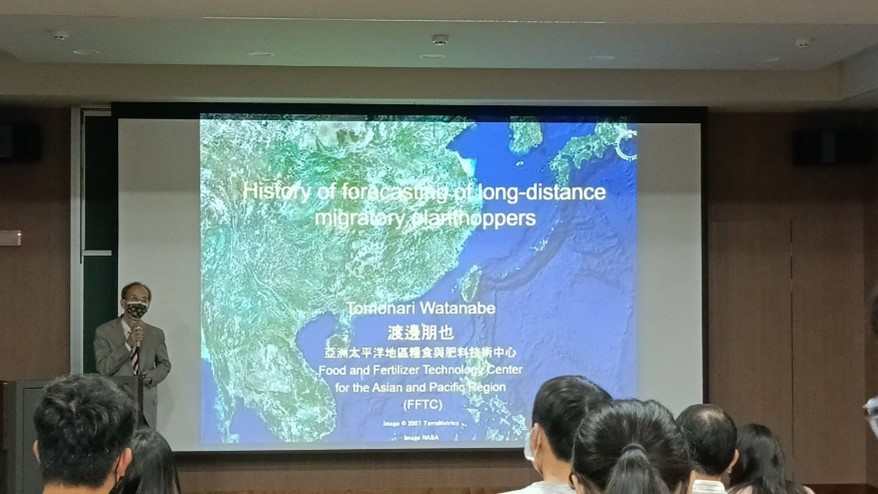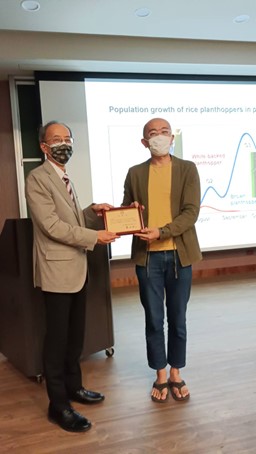History of forecasting of long-distance migratory planthoppers
編輯:林芳伶、林家揚、簡思音

演講者Dr. Tomonari Watanabe
Food and Fertilizer Technology Center for the Asian and Pacific Region (FFTC)
主持人 Dr. Toshinori Okuyama
Department of Entomology, National Taiwan University
演講日期 (Date): 2022/05/03(二) 11:20-12:20
課程內容與新知
Dr. Tomonari Watanabe is a distinguished researcher in Japan and is currently in the Food and Fertilizer Technology Center for the Asian and Pacific Region (FFTC). His talk was mainly about the prediction of planthopper migration from the usage of traditional methods to modern technology. Planthoppers are one of the most serious insect pests in Japan, as these pests suck plant sap which usually result to plant death. Pest invasion was serious that it often caused huge famines in Japan. Thereafter, several control strategies were adopted from a textbook published in 1826 “How to control the planthoppers”, where farmers are suggested to use a type of oil applied on the plant (ex. rice) so that the pest cannot latch on the plant and suck the sap. These techniques were used until chemical pesticides were recommended to use as control for these pests.
Now the question is: Where did these planthoppers come from? Did these pests just overwinter in Japan? Or were they from overseas? An Epoch making discovery occurred around 1966 when a great number of insect species, including the white-back planthoppers and brown planthoppers invaded a weather observation ship (Tango) on the Pacific Ocean. Big swarms of these planthoppers attacked the ship around July, where it suggested that these westerly winds most probably assisted in the flight route of the planthopper to Japan. From 1968 to 2009, bug-catching nets were attached on weather ships to survey planthopper migration on East China Sea.
Wind direction analysis (1987) procedure was used where they receive a weather chart from a weather facsimile, and data was put into the computer to calculate the wind distribution map. After having the wind map drawn, it is sent to collaborative institutes and prefectural plant protection offices where they could analyze the relationship between LLJET (Low-level Jetstream) development and planthopper migration. Not long after, Japan Plant Protection General Information Network System (JPP-NET) was created where it could provide information on pest occurrences, weather database, forecasting models, pesticide registration data, photo libraries, and a lot more. One drawback of monitoring LLJET is that it cannot predict the migration intensity of the planthoppers. Therefore, they collaborated with the Japan Atomic Energy Research Institute and applied WSPEEDI to create better and accurate planthopper migration forecasting.
In addition to the monitoring of planthoppers in Asia, forecasting where different kinds of simulations can be done and where insect characteristic change can be observed, control and management of these pests can move to a better stride.
Q&A
Q1: Is there any trap used in japan to control the pests, planthoppers, which invade from China into Japan?
A1: No, it’s really hard to catch them by traps because their size is too small. People used to control them by light trap, but the efficiency was still not very well. So most people use chemical pesticide to suppress the population of planthoppers now in Japan.
Q2: From G0, G1 to G2 generation, why did the population of white back planthopper decrease but population of brown planthopper continuously increase after G1 generation?
A2: The main reason is that the life of planthopper depends on the rice growth stage. After G1 generation hatched, the rice growth stage was not good for white back planthopper to maintain their population. So they turned into long wing form and migrated to other place. That’s why after G1 generation, the population of white back planthopper decreased.
Q3: In past few years, was their population affected by the global warming or climate change? If so, is there any evidence?
A3: Yes, some people said that their population was affected by the global warming and climate change. We don’t have the actual evidence yet. However, based on our results, their migration mainly depended on the monsoon.
花絮照片 (other photos) 3-5張


